Lian Li PE-750 SFX-L 750W PSU Review
Lian Li enters the PSU market again with two new SFX-L models featuring 550 W and 750 W capacities. The PE-750 is under the microscope today. It features modular cabling, a single +12V rail, and a semi-passive fan.
Why you can trust Tom's Hardware
A Look Inside And Component Analysis
Parts Description
Before proceeding with this page, we strongly encourage you to a look at our PSUs 101 article, which provides valuable information about PSUs and their operation, allowing you to better understand the components we're about to discuss. Our main tools for disassembling PSUs are a Thermaltronics soldering and rework station, and a Hakko FR-300 desoldering gun.
| General Data | |
|---|---|
| Manufacturer (OEM) | Enhance Electronics |
| Primary Side | |
| Transient Filter | 4x Y caps, 3x X caps, 2x CM chokes, 1x MOV, 1x CMD02X |
| Inrush Protection | NTC Thermistor & Relay |
| Bridge Rectifier(s) | 1x GBU15L06 (600 V, 15 A @ 115 °C) |
| APFC MOSFETs | 2x GP28S50X (650 V, 11 A @ 100 °C, 0.19 Ω) |
| APFC Boost Diode | 1x CREE C3D10060A (600 V, 10 A @ 153 °C) |
| Hold-up Cap(s) | 2x Rubycon (420 V, 270 uF each, 3000 h @ 85 °C, USG) |
| Main Switchers | 2x Infineon IPP50R140CP (550 V, 15 A @ 100 °C, 0.14 Ω) |
| Driver IC | 1x Silicon Labs Si8230BD |
| APFC Controller | Champion 6502TX & CM03X Green PFC controller |
| Switching Controller | Champion CM6901 |
| Topology | Primary side: Half-Bridge & LLC Resonant Converter Secondary side: Synchronous Rectification & DC-DC converters |
| Secondary Side | |
| +12V MOSFETs | 8x Infineon BSC014N04LS (40 V, 100 A @ 100 °C, 1.4 mΩ) |
| 5V & 3.3V | DC-DC Converters: 4x Infineon BSC018NE2LS (25 V, 97 A @ 100 °C, 1.8 mΩ) PWM Controller: 2x ANPEC APW7073 |
| Filtering Capacitors | Electrolytics: Chemi-Con (105 °C, KY), Duratech (125 °C), Unicon (125 °C, UPL), Rubycon (105 °C, ZLH, YXG) Polymers: Unicon |
| Supervisor IC | SITI PS223 (OVP, UVP, OCP, SCP, OTP ) |
| Fan Model | Globe Fan S1201512HB (120 mm, 12 V, 0.45 A, Sleeve Bearing) |
| 5VSB Circuit | |
| Rectifier | 1x PFR10V45CT (45 V, 5 x 2 A) |
| Standby PWM Controller | Sanken STR-A6069H |
| -12V Circuit | |
| Rectifier | L7912CV (1.5 A) |





Again, this PSU is based on an SFX-L platform provided by Enhance Electronics, one of the most experienced OEMs thanks to its collaboration with SilverStone. The PE-750's platform uses a large heat sink on the primary side, which we had to desolder since it totally blocked our view of significant components. Fighting with large Enhance heat sinks is never easy, even when you have advanced soldering equipment and know how to use it. A half-bridge topology is utilized on the primary side, along with an LLC resonant converter. On the secondary side we find a synchronous design and a couple of voltage regulator modules for generating the minor rails. The filtering capacitors are of high quality; most of them come from Rubycon. Unfortunately, the cooling fan's bearing isn't up to the standards of this price category.





The EMI filter includes two Y caps and two X ones on the first stage, and two Y caps, a single X one, two CM chokes, and an MOV on the second stage. There is also a CMD02X that blocks current through an X cap's discharge resistor when AC voltage is connected, and automatically discharges the cap through the corresponding resistor when AC is disconnected.


An NTC thermistor is used to lower the inrush currents. It is supported by a bypass relay, which lowers the thermistor's cool-down period and provides a small efficiency boost.
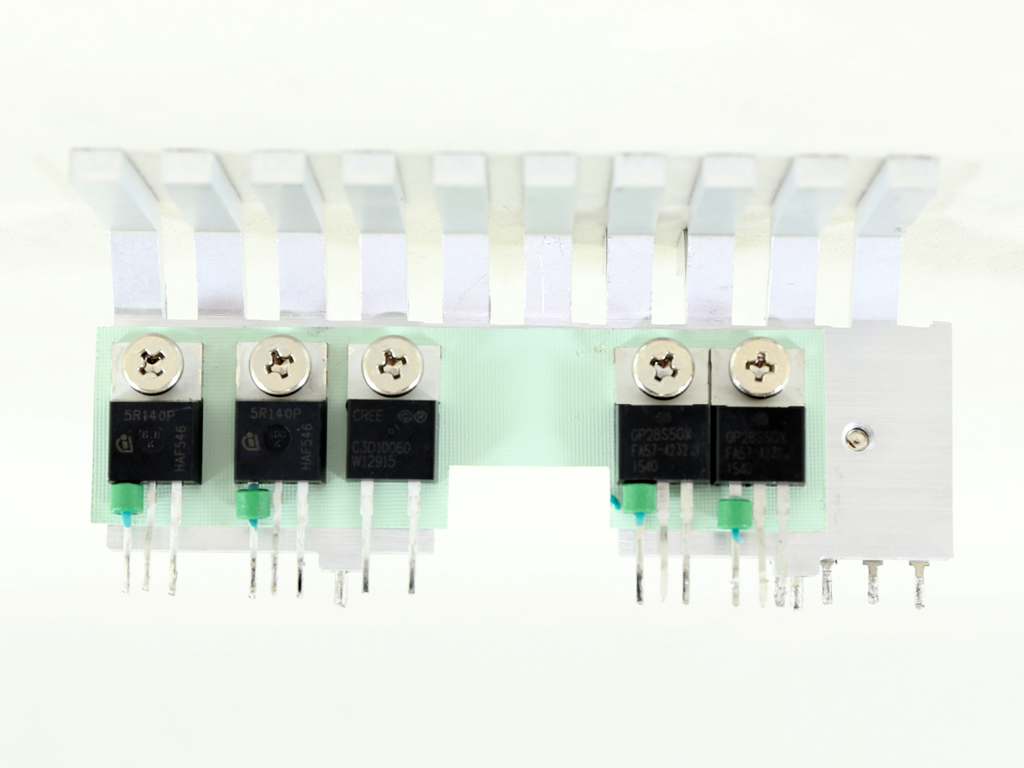





A huge primary heat sink hosts the GBU15L06 bridge rectifier, along with a couple of GP28S50X FETs and a CREE C3D10060A boost diode for the APFC converter. The big let-down here is the quality of the bulk caps. They might be provided by Rubycon (one of the best cap manufacturers), but their maximum temperature rating is only 85 °C. According to the official specs, the USG Rubycon caps last 3000 hours at 85 °C, so we can calculate that their lifetime is around 2.12 years at 50 °C ambient using this formula, and with an assumed 10 °C increase in their operating temperature because of current ripple. A 105 °C cap with a 2000-hour rating has a 5.63 year lifetime under the same conditions. As you can see, the difference is huge. That's why we only want to see 105 °C caps on the APFC converter.
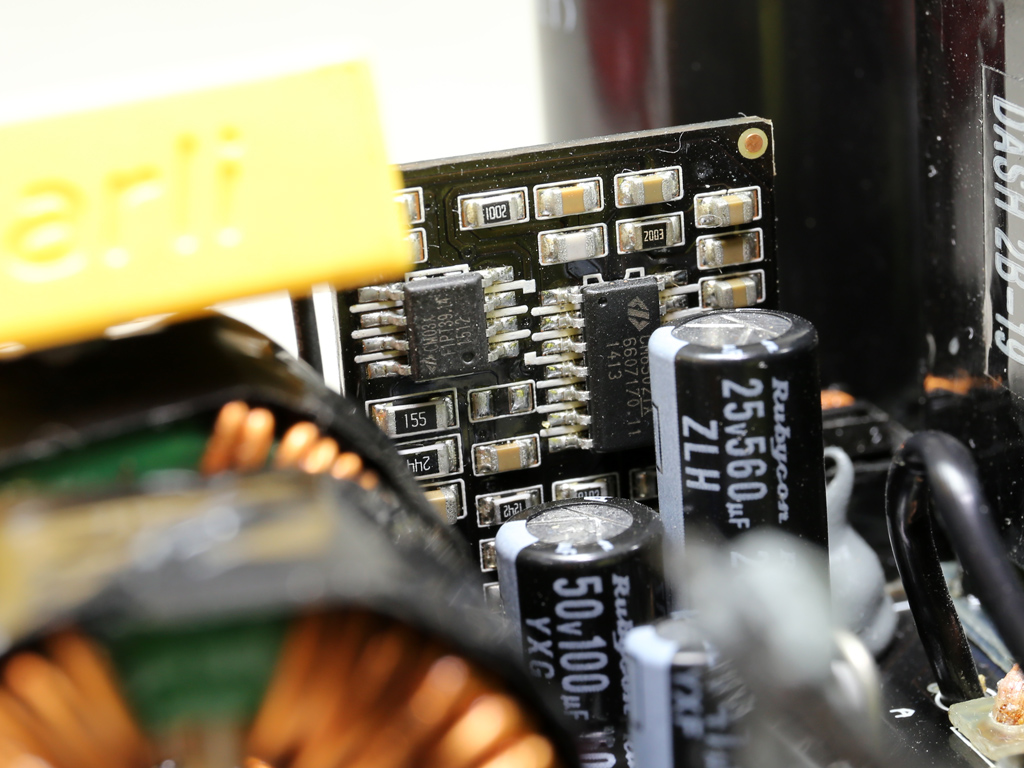

A small daughterboard hosts the PFC controller, a Champion 6502TX, along with a CM03X Green PFC controller.



The main switchers, two Infineon IPP50R140CP FETs, are configured in a half-bridge topology. An LLC resonant converter is used for increased efficiency, and the corresponding controller is a Champion CM6901 installed on the rear side of the modular PCB. The driver IC for the primary FETs is a Silicon Labs Si8230BD.
Get Tom's Hardware's best news and in-depth reviews, straight to your inbox.


On the secondary side, the FETs that regulate the +12V rail are installed on the solder side of the main PCB, and are cooled mostly by the chassis. In total, eight Infineon BSC014N04LS are used for this purpose.
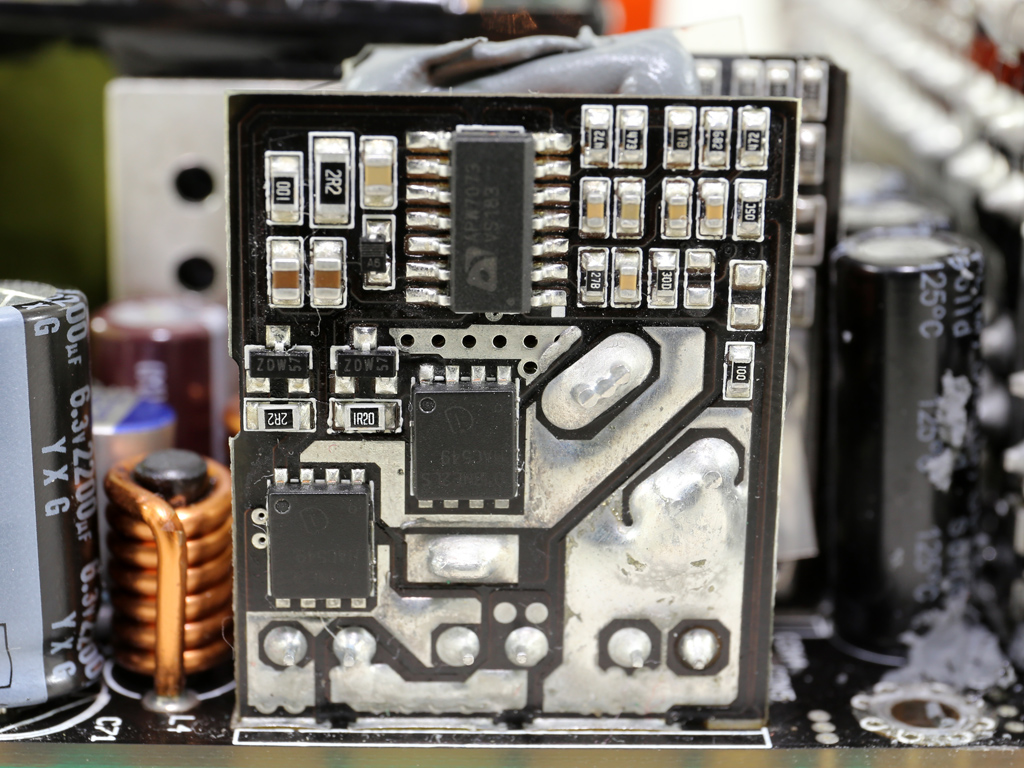



A couple of small VRMs hold an ANPEC APW7073 PWM controller and two Infineon BSC018NE2LS FETs each. Those regulators handle the minor rails and look quite strong, although Lian Li states that the minor rails are restricted to 80 W max combined power.




Mostly electrolytic caps are used for filtering purposes. They're provided by Chemi-Con, Rubycon, Unicon, and Duratech, though we also find a single polymer cap sourced by Unicon. The Chemi-Con and Rubycon caps are rated at 105 °C, while the Unicon and Duratech caps have an even higher 125 °C temperature rating since they use solid electrolyte.
The back side of the modular board hosts the supervisor IC, a SITI PS223, which supports over-temperature protection out of the box. This IC also has two OCP channels for monitoring an equal number of +12V rails, though the PE-750 only employs one +12V rail.



The 5VSB rail is regulated by a PFR10V45C SBR and the standby PWM controller is a Sanken STR-A6069H IC. There is also an SG30N04D installed on the modular PCB, which most likely is used to feed the 5VSB rail from the 5V one, once the PSU is in operation.
The -12V rail is handled by a L7912CV regulator. It is nice to see a proper regulator used instead of a plain diode for this unimportant rail, which is no longer required by the most recent ATX specification.

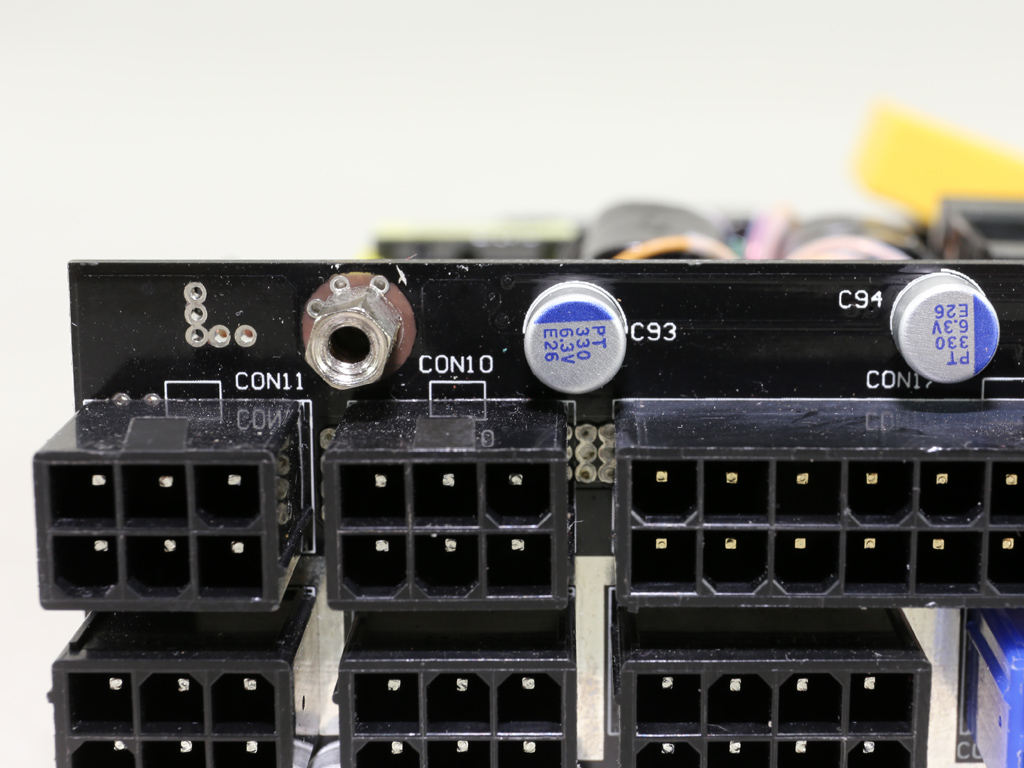

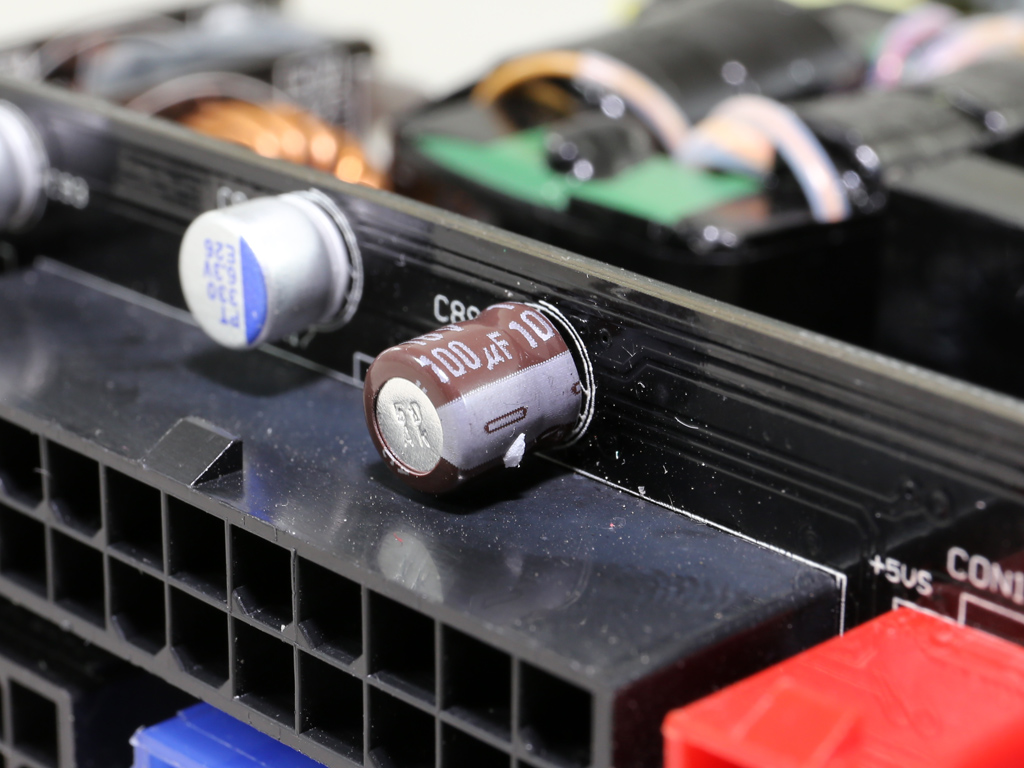
At the front side of the modular PCB, several Unicon polymer caps and a single Chemi-Con electrolytic cap filter the rails.
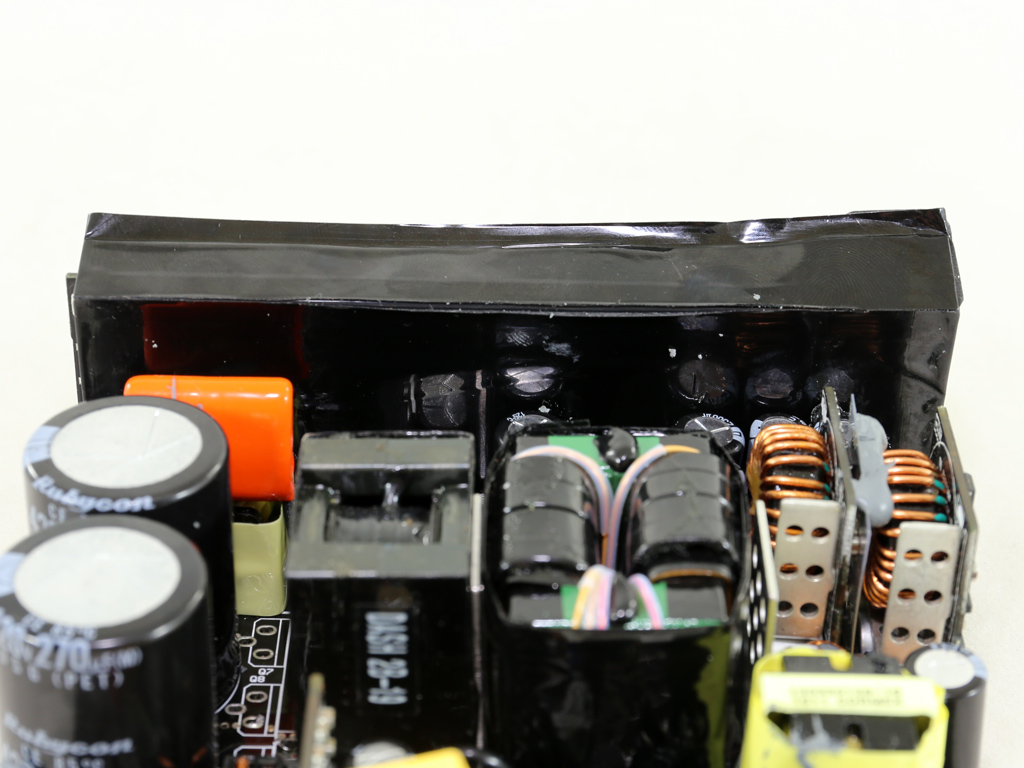


The rear side of the same PCB is protected by a large metallic board covered by black tape, though this doesn't offer the best EMI protection since it isn't grounded.




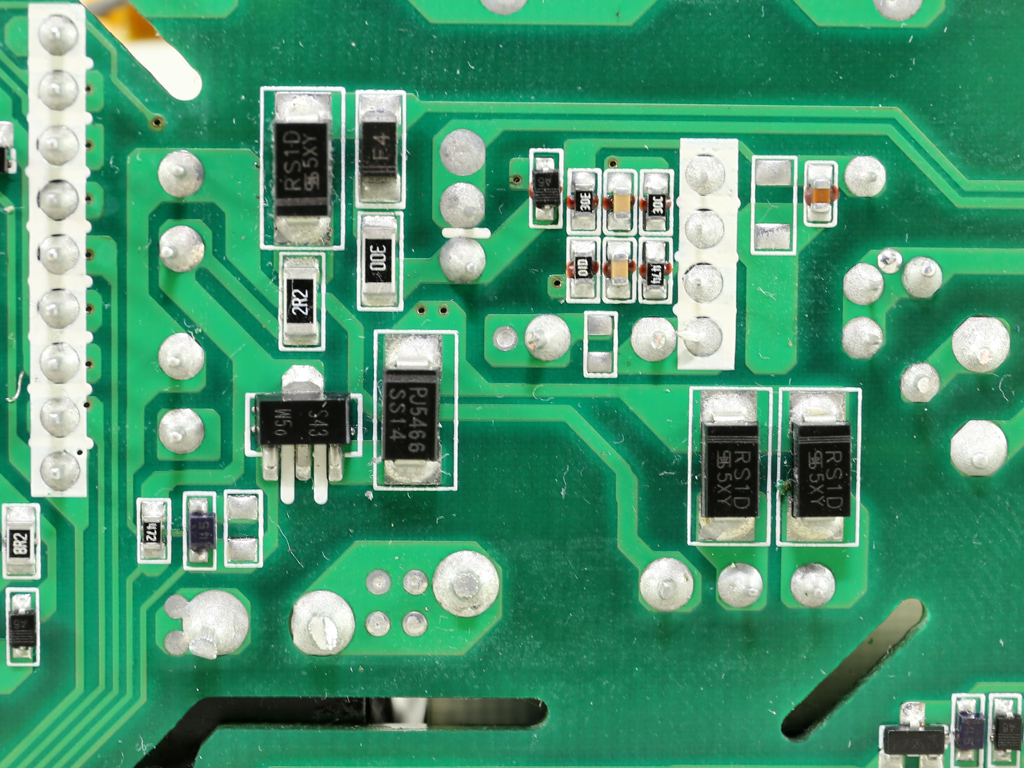
The soldering quality is pretty good, and there are no long component leads. On the secondary side, a PCB trace that transfers earth to the modular board is enhanced by a copper wire providing increased conductivity.


The cooling fan is made by Globe Fan and its model number is S1201512HB (120 mm, 12 V, 0.45 A). It is a great shame to see a plain sleeve-bearing fan used in such an expensive PSU. Thankfully, the semi-passive mode should relieve some burden from the fan, allowing it to last longer.
Given the sleeve-bearing fan and 85 °C bulk caps, we no longer wonder why Lian Li chose the warranty duration it did.
Current page: A Look Inside And Component Analysis
Prev Page Packaging, Contents, Exterior, And Cabling Next Page Load Regulation, Hold-Up Time, And Inrush Current
Aris Mpitziopoulos is a contributing editor at Tom's Hardware, covering PSUs.
-
Aris_Mp For the SFX-L standards actually it is quite good. There is next to zero competition in this field. With a few part changes this platform has potential, however I don't know if it could keep efficiency at the same high levels.Reply -
shrapnel_indie Lian Li is supposed to be a premium brand. Just look how expensive (and the usual quality of) their cases are when you can find them. By the numbers and its internals, this doesn't look like a premium brand product, regardless of how much or how little competition they got in a given market.Reply
Lian Li, have you decided to no longer be a true premium brand? -
Valantar Definitely disappointing. Looks like Lian Li is going for the "money to burn, don't care" market. This PSU had amazing promise, but the choice of fan, the too-small caps and the short warranty make this unbuyable. Now, I don't have empirical data to base this on, but I'd guess most people springing $160 on a PSU - SFX or not - want it to last more than 2-3 years. And using a fan that's both short-lived _and_ unsuitable for horizontal mounting? That's just idiotic.Reply -
Virtual_Singularity Solid review, as always, great job Aris. Even if this isn't an ideal psu, Lian Li is a quality brand, a quality case brand. However, its worth noting that of the ample (edit: particularly sfx/sfxl) PSU's Enhance has OEM'd for various brands, this one has to be among the best of them. Even if Lian Li introduced an absolutely horrible psu, wouldn't matter much to their fans, its the quality they put into many of their cases that's most important. Even if they cave more than they already have to the recent case trends, I hope they still keep producing no nonsense cases for that niche market that still values them.Reply -
Valantar Reply18666014 said:Solid review, as always, great job Aris. Even if this isn't an ideal psu, Lian Li is a quality brand, a quality case brand. However, its worth noting that of the ample PSU's Enhance has OEM'd for various brands, this one has to be among the best of them. Even if Lian Li introduced an absolutely horrible psu, wouldn't matter much to their fans, its the quality they put into many of their cases that's most important. Even if they cave more than they already have to the recent case trends, I hope they still keep producing no nonsense cases for that niche market that still values them.
Sure, Lian Li makes great cases (although IMHO they too often screw up their nice minimalist looks with unnecessary clutter, and they're way behind the times in a few usability/ease of build areas today). But how does this relate to this PSU? In no way at all. Lian Li might be "a quality brand, a quality case brand", but that does nothing to change the fact that this is a premium priced PSU built with mind-boggling cost cutting in key areas, making its lifetime radically shorter than it should be. This would barely be okay for a $60 PSU. For a $160 unit, it's not only a deal breaker, it's about on the same level as the engineers shouting "F*ck you!" to every individual buyer. -
Virtual_Singularity Reply18670375 said:18666014 said:Solid review, as always, great job Aris. Even if this isn't an ideal psu, Lian Li is a quality brand, a quality case brand. However, its worth noting that of the ample PSU's Enhance has OEM'd for various brands, this one has to be among the best of them. Even if Lian Li introduced an absolutely horrible psu, wouldn't matter much to their fans, its the quality they put into many of their cases that's most important. Even if they cave more than they already have to the recent case trends, I hope they still keep producing no nonsense cases for that niche market that still values them.
Sure, Lian Li makes great cases (although IMHO they too often screw up their nice minimalist looks with unnecessary clutter, and they're way behind the times in a few usability/ease of build areas today). But how does this relate to this PSU? In no way at all. Lian Li might be "a quality brand, a quality case brand", but that does nothing to change the fact that this is a premium priced PSU built with mind-boggling cost cutting in key areas, making its lifetime radically shorter than it should be. This would barely be okay for a $60 PSU. For a $160 unit, it's not only a deal breaker, it's about on the same level as the engineers shouting "F*ck you!" to every individual buyer.
Fwiw, I've no need of this form factor in a psu, so I'm really not bothered by it so much. But take the comment Aris made above into account. TBH, it'd be very easy to come to your conclusion if not for this psu being in the SFXL category. It really is one of the better ones I've seen reviewed, despite the short warranty. A shorter warranty is typical of the latest comparable units, (Silverstone, for example, has 2-3 years depending on location) the exception being Corsair, possibly. I say possibly because I don't know how their latest sfx units, despite having a longer warranty, compare with this one in overall efficiency, performance. and size.
The latest platinum/titanium rated SFX/SFX-L units carry a price premium. For those demanding a sfx-l unit, the one reviewed above is among the best performers, regardless of it's short warranty. -
blazorthon Problem is that it has multiple issues that are not inherent of being a smaller form factor such as SFX. Lian Li could have simply used a better, same-sized fan. There is also enough room for better caps. Being expensive just because of its efficiency with no regard for long-term reliability is idiotic and contradictory to being a high-end PSU in the first place.Reply -
gadgety Great to highlight the weaknesses of this PSU. How does it compare to the Silverstone SX700-LPT? Which one is best. Do a shootout, or do an comparison piece.Reply

